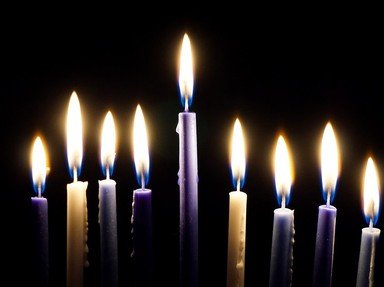Quiz Answer Key and Fun Facts
1. Since Hanukkah celebrates the Miracle of Oil, fried foods are a big part of the festivities (no matter what the healthy food pyramid says). What is the name for these fried patties made from grated potato?
2. The shredded potatoes have been fried up, and are now being served. They may be served with many different toppings, but one of these is aligned with the traditions of Hanukkah. Which of these is it?
3. These thin pancakes are cooked year-round, but at Hanukkah they are likely to be wrapped around a cheese filling. What is their name?
4. This treat is not consumed exclusively at Hanukkah, but the smear of cream cheese on it definitely qualifies it as an appropriately dairy-product laden selection for your breakfast. What is the name for this torus-shaped bread, which is traditionally boiled before it is baked?
5. This piscine treat is enjoyed year-round, but often features on holiday dinner tables. What dish is prepared by poaching the minced flesh of a fish, mixed with eggs, onion, bread crumbs and spices?
6. Cupcakes are a favorite sweet treat with many, but not essentially a part of the Hanukkah tradition. To make them fit appropriately with the celebrations, what colors can be used to decorate them?
7. These freshly-fried doughnuts are a popular Hanukkah treat, especially in Israel where they originated. What is the Hebrew name for one of these doughnuts, traditionally filled with jam and rolled in powdered sugar?
8. This sweet treat is suitable for Hanukkah because of its dairy content, even though it is usually not fried. What is pictured here?
9. It's always fun to make holiday cookies in special shapes suitable for the occasion. If you want to make yours in the shape of a popular symbol of Hanukkah, which of these would be most appropriate?
10. What is the name given to the chocolate coins traditionally distributed at Hanukkah, and often used by children in the traditional game of the season?
Source: Author
looney_tunes
This quiz was reviewed by FunTrivia editor
trident before going online.
Any errors found in FunTrivia content are routinely corrected through our feedback system.


